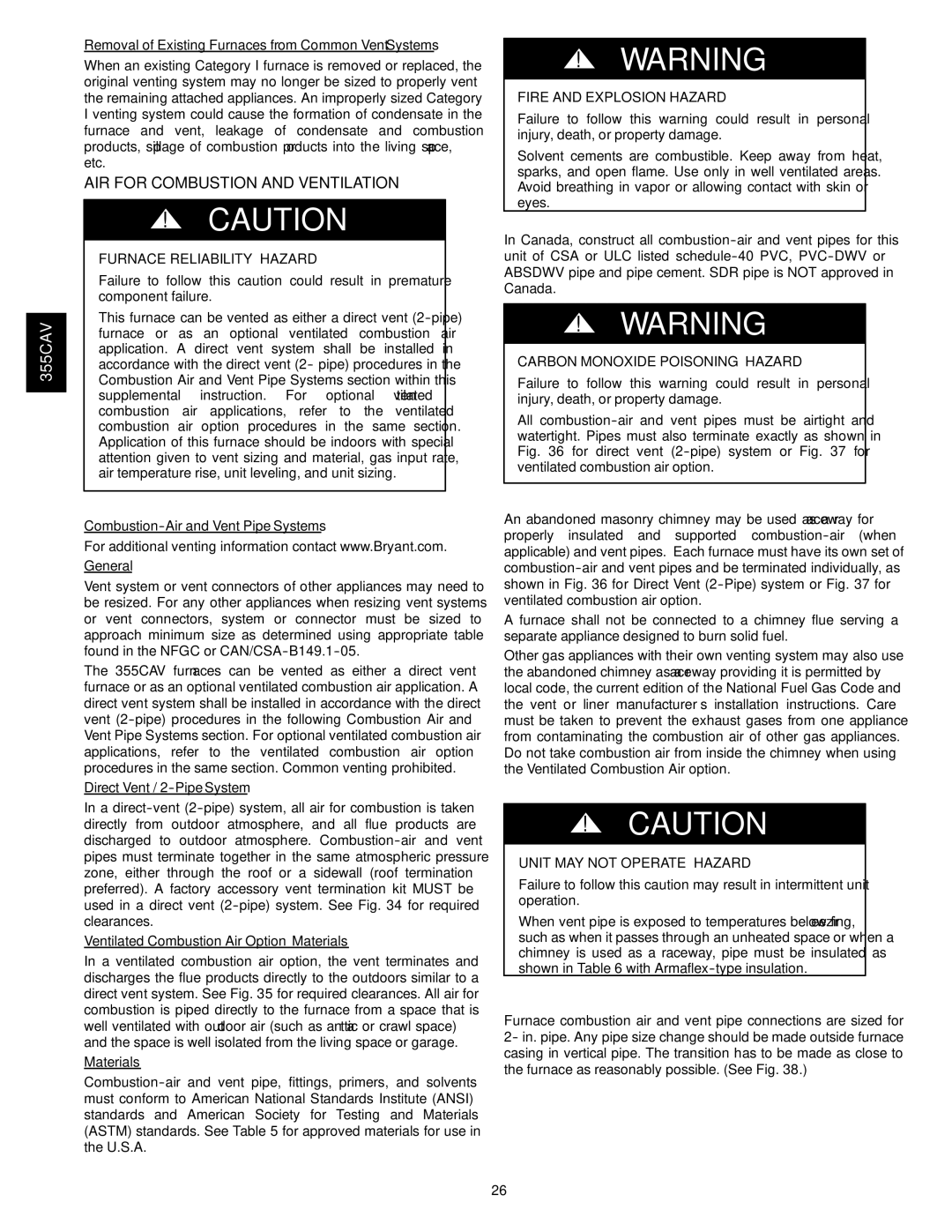Removal of Existing Furnaces from Common Vent Systems
When an existing Category I furnace is removed or replaced, the original venting system may no longer be sized to properly vent the remaining attached appliances. An improperly sized Category I venting system could cause the formation of condensate in the furnace and vent, leakage of condensate and combustion products, spillage of combustion products into the living space, etc.
AIR FOR COMBUSTION AND VENTILATION
!CAUTION
FURNACE RELIABILITY HAZARD
Failure to follow this caution could result in premature component failure.
This furnace can be vented as either a direct vent (2-pipe) furnace or as an optional ventilated combustion air application. A direct vent system shall be installed in accordance with the direct vent (2- pipe) procedures in the Combustion Air and Vent Pipe Systems section within this supplemental instruction. For optional ventilated combustion air applications, refer to the ventilated combustion air option procedures in the same section. Application of this furnace should be indoors with special attention given to vent sizing and material, gas input rate, air temperature rise, unit leveling, and unit sizing.
Combustion-Air and Vent Pipe Systems
For additional venting information contact www.Bryant.com.
General
Vent system or vent connectors of other appliances may need to be resized. For any other appliances when resizing vent systems or vent connectors, system or connector must be sized to approach minimum size as determined using appropriate table found in the NFGC or CAN/CSA-B149.1-05.
The 355CAV furnaces can be vented as either a direct vent furnace or as an optional ventilated combustion air application. A direct vent system shall be installed in accordance with the direct vent (2-pipe) procedures in the following Combustion Air and Vent Pipe Systems section. For optional ventilated combustion air applications, refer to the ventilated combustion air option procedures in the same section. Common venting prohibited.
Direct Vent / 2-Pipe System
In a direct-vent (2-pipe) system, all air for combustion is taken directly from outdoor atmosphere, and all flue products are discharged to outdoor atmosphere. Combustion-air and vent pipes must terminate together in the same atmospheric pressure zone, either through the roof or a sidewall (roof termination preferred). A factory accessory vent termination kit MUST be used in a direct vent (2-pipe) system. See Fig. 34 for required clearances.
Ventilated Combustion Air Option Materials
In a ventilated combustion air option, the vent terminates and discharges the flue products directly to the outdoors similar to a direct vent system. See Fig. 35 for required clearances. All air for combustion is piped directly to the furnace from a space that is well ventilated with outdoor air (such as an attic or crawl space) and the space is well isolated from the living space or garage.
Materials
Combustion-air and vent pipe, fittings, primers, and solvents must conform to American National Standards Institute (ANSI) standards and American Society for Testing and Materials (ASTM) standards. See Table 5 for approved materials for use in the U.S.A.
!WARNING
FIRE AND EXPLOSION HAZARD
Failure to follow this warning could result in personal injury, death, or property damage.
Solvent cements are combustible. Keep away from heat, sparks, and open flame. Use only in well ventilated areas. Avoid breathing in vapor or allowing contact with skin or eyes.
In Canada, construct all combustion-air and vent pipes for this unit of CSA or ULC listed schedule-40 PVC, PVC-DWV or ABSDWV pipe and pipe cement. SDR pipe is NOT approved in Canada.
!WARNING
CARBON MONOXIDE POISONING HAZARD
Failure to follow this warning could result in personal injury, death, or property damage.
All combustion-air and vent pipes must be airtight and watertight. Pipes must also terminate exactly as shown in Fig. 36 for direct vent (2-pipe) system or Fig. 37 for ventilated combustion air option.
An abandoned masonry chimney may be used as a raceway for properly insulated and supported combustion-air (when applicable) and vent pipes. Each furnace must have its own set of combustion-air and vent pipes and be terminated individually, as shown in Fig. 36 for Direct Vent (2-Pipe) system or Fig. 37 for ventilated combustion air option.
A furnace shall not be connected to a chimney flue serving a separate appliance designed to burn solid fuel.
Other gas appliances with their own venting system may also use the abandoned chimney as a raceway providing it is permitted by local code, the current edition of the National Fuel Gas Code and the vent or liner manufacturer’s installation instructions. Care must be taken to prevent the exhaust gases from one appliance from contaminating the combustion air of other gas appliances. Do not take combustion air from inside the chimney when using the Ventilated Combustion Air option.
!CAUTION
UNIT MAY NOT OPERATE HAZARD
Failure to follow this caution may result in intermittent unit operation.
When vent pipe is exposed to temperatures below freezing, such as when it passes through an unheated space or when a chimney is used as a raceway, pipe must be insulated as shown in Table 6 with Armaflex-type insulation.
Furnace combustion air and vent pipe connections are sized for 2- in. pipe. Any pipe size change should be made outside furnace casing in vertical pipe. The transition has to be made as close to the furnace as reasonably possible. (See Fig. 38.)

